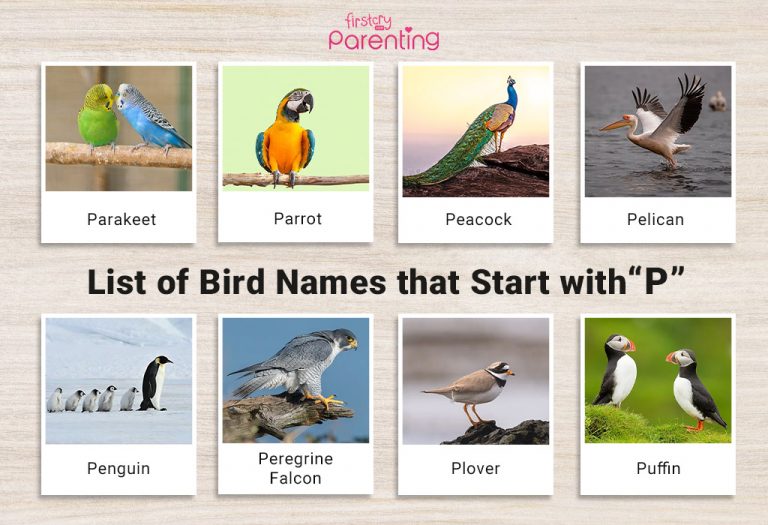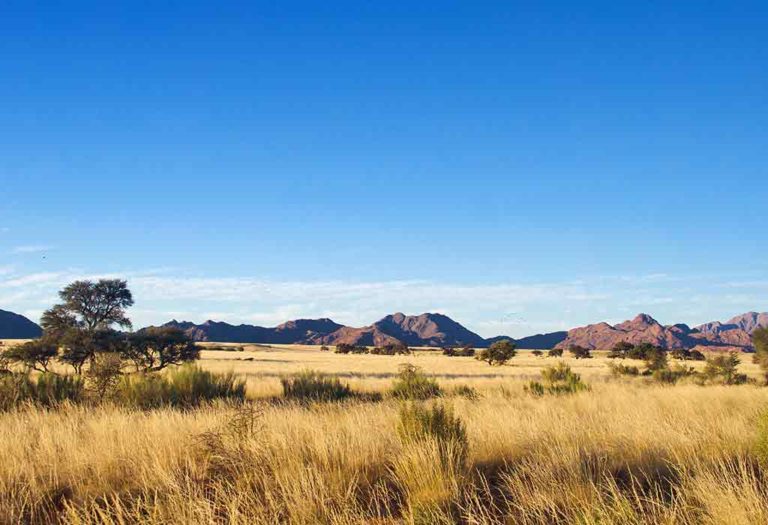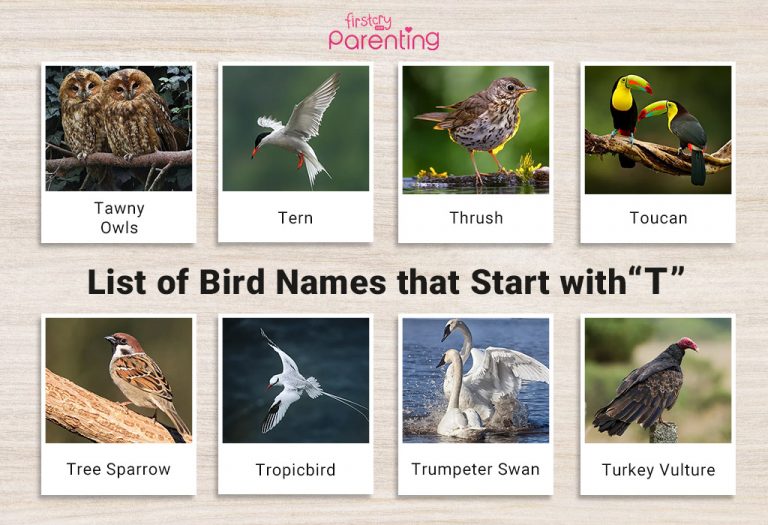List of Birds That Start With P
- List of Common Birds That Start With P
- Other Birds Beginning With P
- FAQs
- Birds Names That Begin With (A to Z)
To all the enthusiastic bird lovers and curious minds out there, we’ve crafted a delightful read just for you. Embarking on a journey through the avian world, we’ve collated a list of bird names that start with the letter P. Perfect for preschoolers and kids; this list will be a fantastic addition to their budding vocabulary. These birds’ radiant plumage and fascinating behaviours are sure to captivate young minds. Whether you’re an educator searching for ‘P letter bird names for preschoolers and kids’ or parents looking to enhance their kids’ vocabulary, this guide will be an enchanting experience. Let’s spread our wings and soar into this alphabetical adventure!
List of Common Birds That Start With P
As we embark on this feathery journey, let’s take a moment to marvel at some common birds, beginning with the letter P. These birds have etched their presence in various habitats around the globe. From dense forests to vast wetlands, here’s a selection of birds whose names start with our chosen letter.
1. Pelican
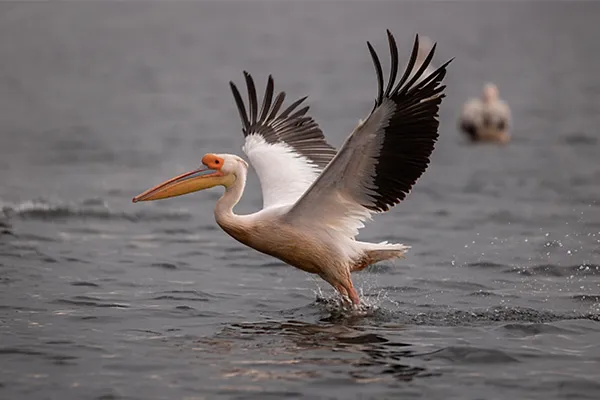
Scientific Name: Pelecanus
Where is it Found: Wetlands, lakes, and coastal waters across the world.
Known for their distinctive long beak and large throat pouch, pelicans are skilled fishers. Their pouch acts as a net, scooping up fish from the water. They are social birds, often gliding gracefully in formation over water bodies. Their plumage can vary from white to brown to grey, depending on the species. A pelican’s wingspan is impressive, making it one of the more recognisable birds beginning with the letter P.
Interesting Facts
- Despite their large size, pelicans are strong fliers, often travelling long distances for food.
- Their throat pouch can hold up to three gallons of water!
2. Parrot
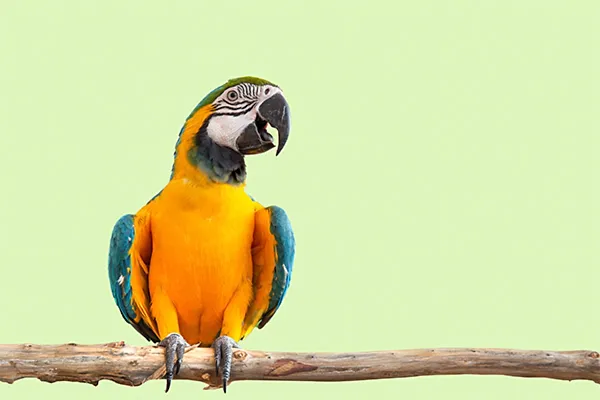
Scientific Name: Psittacidae
Where is it Found: Tropical and subtropical regions around the world.
Parrots are famed for their vibrant colours and skill to mimic sounds, including human speech. Their strong, curved beak is adapted to crack open hard nuts and seeds. These birds have zygodactyl feet, meaning they have two toes facing forward and two facings backwards, which helps them climb and grasp. The bond between a parrot and its mate is often lifelong, showcasing their monogamous nature.
Interesting Facts
- Parrots are among the most intelligent birds.
- Some species can learn and mimic hundreds of words, and they’ve even been known to solve complex puzzles!
Also Read: Important Facts about Parrots for Kids
3. Penguin
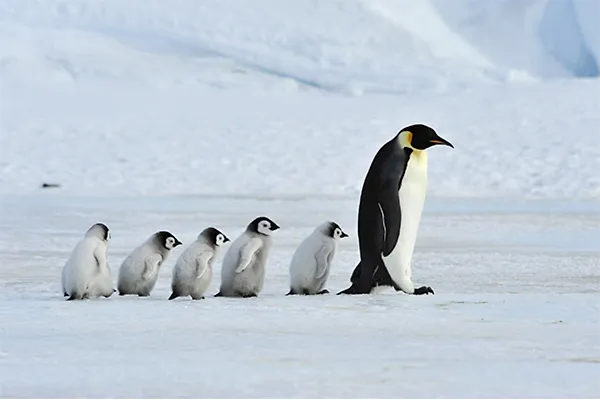
Scientific Name: Spheniscidae
Where is it Found: Predominantly in the Southern Hemisphere, especially Antarctica.
Penguins are flightless birds adapted to life in the water. Their wings have evolved into flippers used for swimming rather than flying. They have a streamlined body to swim faster and can remain underwater for 20 minutes. Their diet primarily consists of fish and krill. Penguins are social animals, often seen in large colonies, huddling together for warmth in colder regions.
Interesting Facts
- Penguins have a gland near their eyes that helps filter out salt from the seawater, allowing them to drink it!
Also Read: Interesting Penguin Facts for Kids
4. Peregrine Falcon
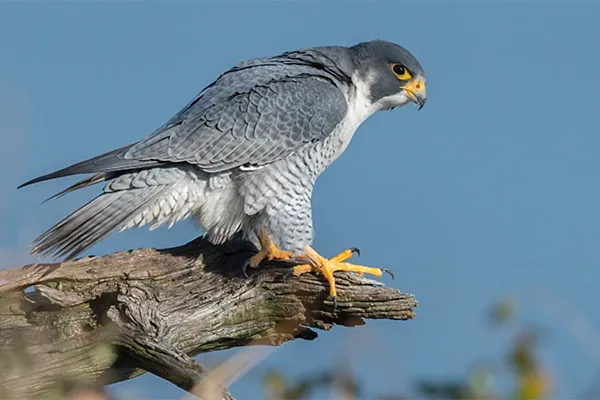
Scientific Name: Falco peregrinus
Where is it Found: Almost everywhere, from tundras to deserts, except extreme polar regions.
Peregrine falcons are renowned for their speed. When they dive to catch prey, they can reach up to 240 mph. They primarily feed on other birds, catching them mid-air after a high-speed chase. The bird’s upper parts are blue-grey, and its underparts are pale with thin, clean streaks.
Interesting Facts
- The peregrine falcon is a widespread bird of prey and can be spotted on every continent except Antarctica!
5. Puffin
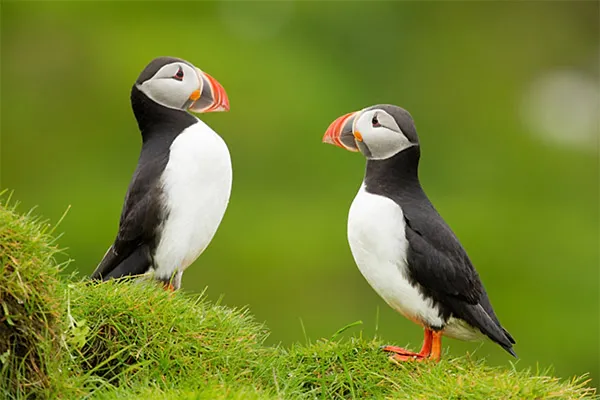
Scientific Name: Fratercula
Where is it Found: Cold coastal regions, especially the North Atlantic Ocean.
Puffins are often called “sea parrots” due to their colourful beak, which becomes more vibrant during the breeding season. They are excellent divers, using their wings to “fly” underwater while chasing fish. These birds are small, stocky, and have black and white plumage.
Interesting Facts
- They can flap their wings 400 times per minute and carry multiple fish in their beak, making them efficient hunters.
6. Peacock
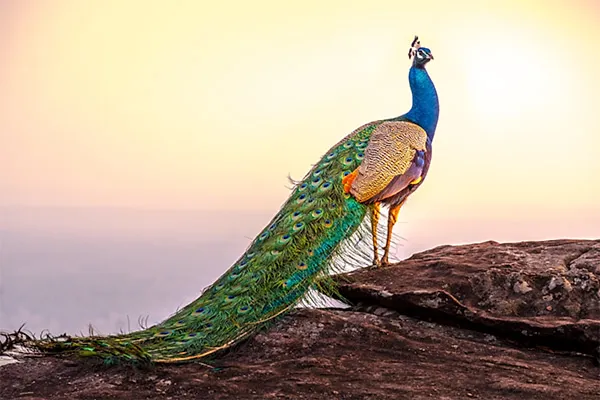
Scientific Name: Pavo cristatus
Where is it Found: Native to South Asia and the Maldives but can also be found in various parts of the world due to domestication.
Peacocks, with their sparkling blue and green plumage, are among the most visually stunning birds on the planet. Males, known for their impressive tail feathers or “train,” use them in a display dance to attract females. The train, which can be fanned out into a spectacular display, contains eye-like patterns that shimmer and move as the peacock dances.
Interesting Facts
- ‘Peacock’ refers only to the male of the species. Females are called ‘peahens’, and the young ones are ‘peachicks’.
Also Read: Facts and Information about Peacocks for Kids
7. Parakeet
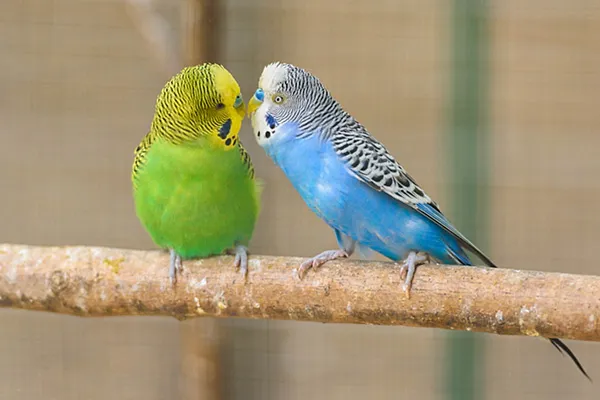
Scientific Name: Psittacula
Where is it Found: Native to warm regions like India, Southeast Asia, and West Africa. They are also popular pets worldwide.
Parakeets are small to medium-sized parrots with long tail feathers. Their colourations vary widely among species but are often bright and noticeable. They are social birds, usually living in flocks, and have a cheerful, chirpy song. Their diet primarily consists of nuts, fruits, seeds, and berries.
Interesting Facts
- The word ‘parakeet’ means ‘little parrot’.
- Many parakeets can learn to talk and are known for their playful nature.
8. Plover
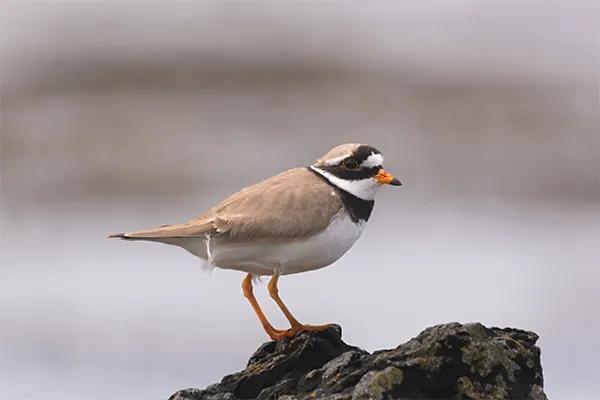
Scientific Name: Charadrius
Where is it Found: Various habitats worldwide, including beaches, grasslands, and wetlands.
Plovers are small—to medium-sized wading birds with short bills that feed mostly on insects, worms, and other small invertebrates. They are known for their characteristic run-and-stop behaviour while foraging. Depending on the species, their plumage can be muted brown or more vivid.
Interesting Facts
- Some species of plovers use a ‘broken-wing act’ to lure predators away from their nests.
9. Ptarmigan
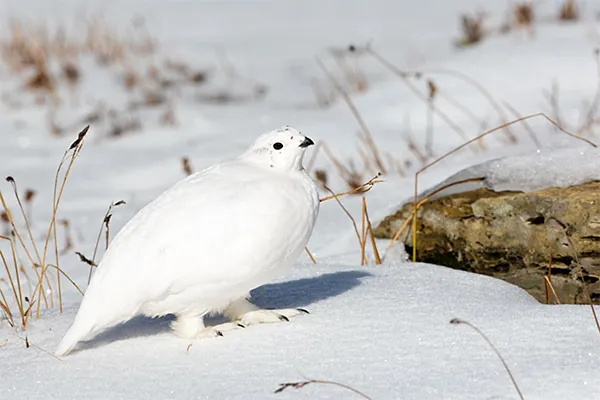
Scientific Name: Lagopus
Where is it Found: Tundras of North America and Eurasia.
Ptarmigans are ground-dwelling birds adapted to cold environments. Their feathered feet act like snowshoes, helping them walk on snow. Their plumage changes colour with the seasons—white in winter to blend in with the snow and brown in summer to match the tundra’s rocks and plants.
Interesting Facts
- The ptarmigan’s name is derived from a Scottish Gaelic word, and despite the initial ‘p’, it’s silent. So, it’s pronounced as ‘TAR-mi-gan’.
10. Partridge
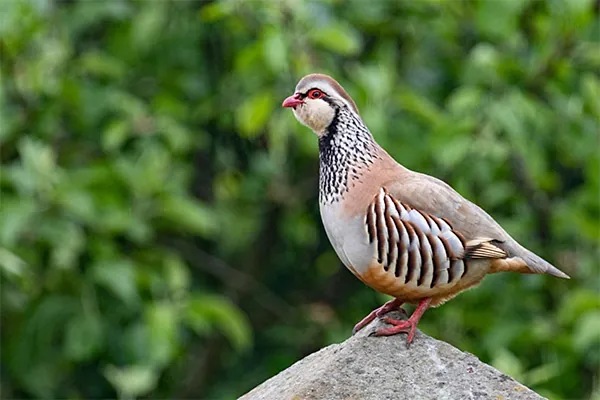
Scientific Name: Perdix
Where is it Found: Europe, Asia, Africa, and the Middle East.
Partridges are ground-nesting birds that usually prefer running to flying when in danger. They have a stout build and are known for their distinctive call. These birds have a varied diet of seeds, grains, and small insects. Their plumage usually blends in with their surroundings, helping them avoid predators.
Interesting Facts
- The Christmas song “The Twelve Days of Christmas”, starts with “a partridge in a pear tree”, highlighting its cultural significance.
11. Phoebe
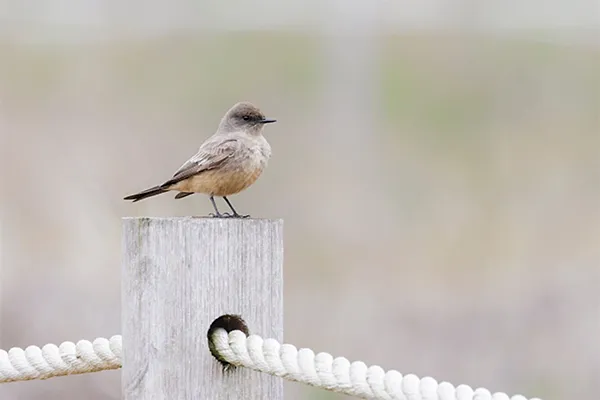
Scientific Name: Sayornis
Where is it Found: North and South America.
Phoebes are small passerine birds known for their soft calls, which often sound like they’re saying “phoebe.” They have a predominantly insectivorous diet and can often be seen perching and darting out to catch flying insects.
Interesting Facts
- Phoebes are known to wag their tails when perched, a characteristic behaviour of this bird.
12. Pipit
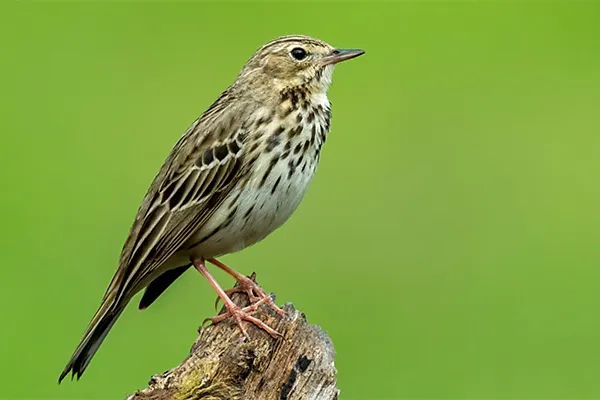
Scientific Name: Anthus
Where is it Found: Meadows, grasslands, and marshes across many parts of the world.
Pipits are small, slender birds, often seen in open landscapes. They possess a streaked appearance and a fine, pointed bill suitable for picking up insects and seeds. Their flight is undulating, characterised by a series of rapid wingbeats. While on the ground, they exhibit a characteristic tail-bobbing behaviour.
Interesting Facts
- Pipits are often confused with the lark family, but one distinguishing feature is their habit of walking (not hopping) on the ground.
13. Pitta
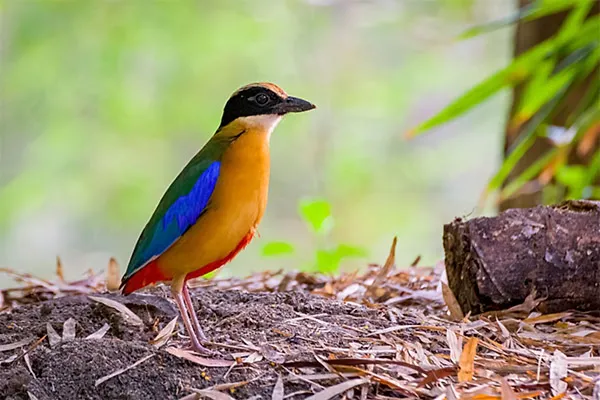
Scientific Name: Pittidae
Where is it Found: Tropical forests of Asia, Africa, and Australasia.
Pittas are brightly coloured, ground-dwelling birds. They have strong legs and often hopped on the forest floor searching for insects. Their vibrant plumage is a mix of blues, greens, reds, and yellows, making them a visual treat in the dense green forests.
Interesting Facts
- Despite their bright colours, pittas can be hard to spot because they are shy and live in dense habitats.
14. Prinia
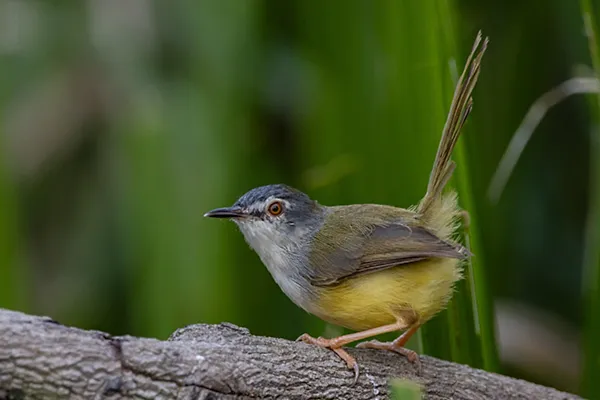
Scientific Name: Prinia
Where is it Found: Grasslands and scrublands of Africa and Asia.
Prinias are small, active birds with long tails often held upright. They have a musical call and are seen flitting through grass and low vegetation for insects. Their slender build and swift movements make them agile foragers.
Interesting Facts
- Many prinias have a distinct seasonal plumage. They might appear quite plain during non-breeding seasons but flaunt a more vibrant look during the breeding season.
15. Prothonotary Warbler
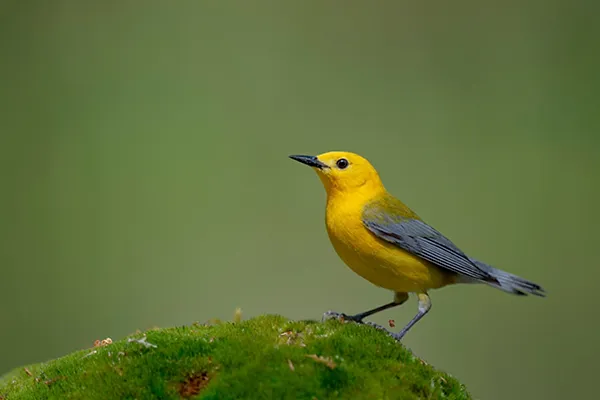
Scientific Name: Protonotaria citrea
Where is it Found: Swamps and wooded areas of Eastern North America.
This warbler boasts a striking golden-yellow head and chest with bluish-grey wings. It gets its unusual name from the bright yellow robes worn by prothonotaries, a rank of Catholic church officials. Prothonotary Warblers are cavity-nesting birds, often occupying old woodpecker holes.
Interesting Facts
- These warblers are strongly associated with water. They often nest near water bodies and even occasionally capture small aquatic prey.
16. Palm Cockatoo
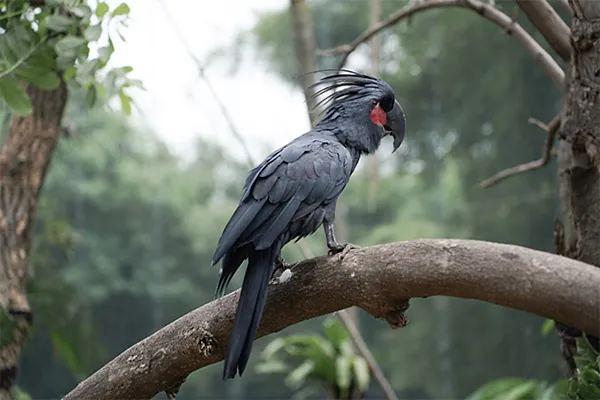
Scientific Name: Probosciger aterrimus
Where is it Found: Rainforest of Australia, New Guinea, and Indonesia.
Palm Cockatoos are large, black, or smoky-grey parrots with a distinctive crest of feathers on their head, which they can raise or lower. Their cheeks have a bright red or pink patch, which can change colour when the bird is excited or agitated. Their massive beak is one of the most powerful parrots, capable of easily breaking hard nuts.
Interesting Facts
- These cockatoos use sticks to drum on tree trunks, a rare tool-using behaviour seen in birds. This drumming is believed to be a form of communication or a display to attract mates.
17. Pied Kingfisher
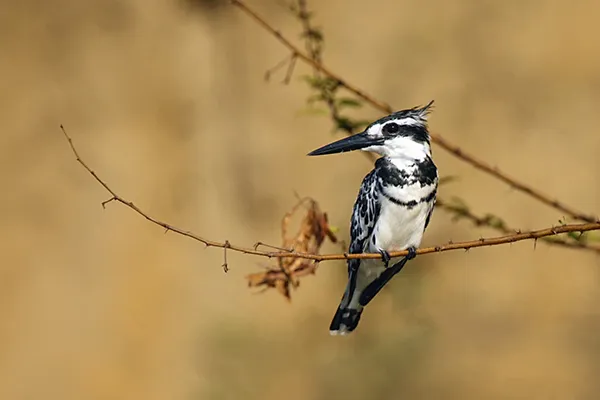
Scientific Name: Ceryle rudis
Where is it Found: Wetlands and water bodies across sub-Saharan Africa and parts of Asia.
With striking black and white plumage, the Pied Kingfisher is often seen hovering over water bodies, diving headfirst to catch fish. Its unique fishing technique allows it to hover mid-air without flapping too much, allowing it to spot and target fish in the water below.
Interesting Facts
- The Pied Kingfisher is one of the few bird species in which females possess a more elaborate appearance than males. Females have a double breastband, while males have just a single one.
18. Pinyon Jay
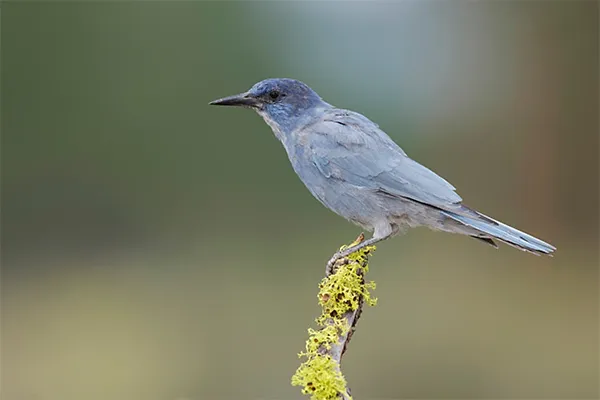
Scientific Name: Gymnorhinus cyanocephalus
Where is it Found: Pine forests of the western United States.
These jays are bluish-grey with a brighter blue head and a short tail. They are highly sociable birds, often seen in large flocks. Their diet consists mainly of pinyon pine seeds, and they play an important role in seed dispersal, helping grow new pine forests.
Interesting Facts
- Pinyon Jays can remember the locations of thousands of stored seeds, ensuring they have food even during the harshest of winters.
19. Pochard
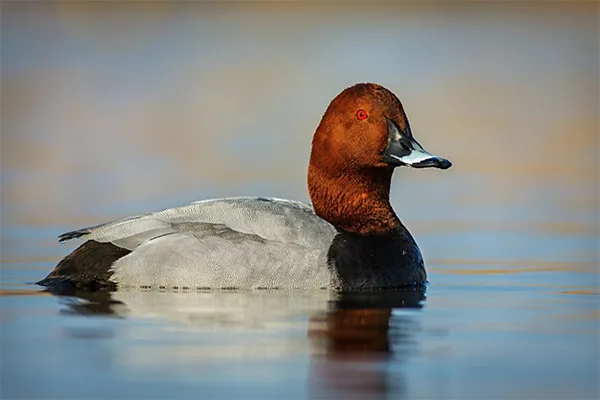
Scientific Name: Aythya ferina
Where is it Found: Wetlands across Europe and Asia.
Pochards are medium-sized diving ducks. Males are distinguished by their chestnut-brown heads and bright red eyes, while females have a more subdued brownish appearance. They feed on aquatic plants, diving deep into the water to forage.
Interesting Facts
- When alarmed or threatened, Pochards often dive instead of flying away, using their excellent diving skills to escape predators.
20. Palmchat
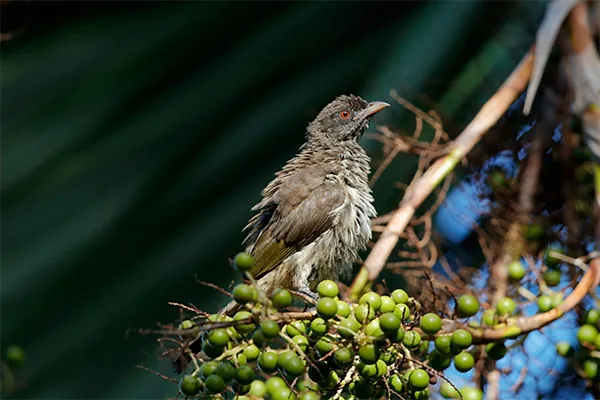
Scientific Name: Dulus dominicus
Where is it Found: Island of Hispaniola in the Caribbean.
The Palmchat is a small bird with a streaked brown appearance and a distinct crest on its head. They build large communal nests on palm trees, with multiple chambers for different pairs. These birds are social and are often seen in groups, foraging for fruits and insects.
Interesting Facts
- It is the national bird of the Dominican Republic. It is unique in that it belongs to its own family, Dulidae, and has no close relatives.
Each of these bird names with P tells a unique tale of evolution, survival, and beauty. As we wrap up our list, it’s evident that the world of birds is as diverse as it is enchanting. From pelicans to puffins, every bird has its unique charm, waiting to be explored and appreciated.
Other Birds Beginning With P
The avian world is incredibly diverse, and each bird plays its unique part in the ecosystem. While we’ve journeyed through some captivating descriptions of birds, starting with the letter ‘P’, many more deserve mention. Whether fluttering in your backyard or residing in distant, exotic lands, each bird starts with the letter P, bringing its charm to the ornithological tableau. Here’s a list to further satiate your birdwatching curiosity:
- Painted Bunting
- Painted Stork
- Pale-billed Woodpecker
- Pallid Harrier
- Palila
- Pallas’s Fish Eagle
- Pallas’s Gull
- Palm Tanager
- Palm-Swift
- Palau Ground Dove
- Pale-blue Monarch
- Pampas Meadowlark
- Panama Flycatcher
- Panay Striped Babbler
- Papuan Hawk-Owl
- Parrot-billed Sparrow
- Parrotfinch
- Pauraque
- Pavonine Cuckoo
- Pearl Kite
- Pectoral Sandpiper
- Pelagic Cormorant
- Pelzeln’s Tody-Tyrant
- Perching Duck
- Perija Thistletail
- Peruvian Booby
- Peruvian Plantcutter
- Peruvian Sheartail
- Peruvian Tern
- Petrel
- Pewee
- Phaeton
- Philippine Drongo-Cuckoo
- Philippine Falconet
- Philippine Trogon
- Philippine Woodcock
- Phoebe Flycatcher
- Phyllastrephus
- Picazuro Pigeon
- Piculet
- Pied Babbler
- Pied Cuckoo
- Pied Currawong
- Pied Falconet
- Pied Goshawk
- Pied Honeyeater
- Pied Imperial Pigeon
- Pied Oystercatcher
- Pied Thrush
FAQs
1. Why do some birds have names starting with the letter P?
Like other animals, birds’ names often derive from characteristics, locations, or people’s names. Birds with names starting with the letter “P” might be named for their appearance, habitat, behaviour, or in honour of someone, just like birds with names starting with other letters.
2. Are all “P” named birds found in the same habitat?
No. Birds with names starting with the letter “P” can be found in various habitats ranging from dense forests to open wetlands and even arid deserts.
3. Which “P” named bird is the most endangered?
Several “P” named birds face threats, but the Philippine Eagle, also known as the monkey-eating eagle, is among the most critically endangered due to habitat loss and hunting.
4. Do any “P” named birds migrate?
Yes, many birds with names starting with “P” migrate. The Pectoral Sandpiper is a known long-distance migrant.
5. Are there any nocturnal birds that start with the letter P?
Yes, there are nocturnal birds starting with the letter “P,” such as the Pauraque and the Papuan Hawk-Owl, which are known for their night-time activities.
In the vast tapestry of nature, birds hold a special place, symbolising freedom, diversity, and evolution. By delving into the world of birds that start with the letter ‘P’, we’ve taken a fascinating journey through diverse habitats, behaviours, and stories. As we soar on the wings of knowledge, let’s continue to cherish and protect these avian wonders, ensuring they remain an integral part of our world for generations.
Birds Names That Begin With (A to Z)
| A | B | C | D | E | F | G | H | I |
| J | K | L | M | N | O | P | Q | R |
| S | T | U | V | W | X | Y | Z |
Was This Article Helpful?
Parenting is a huge responsibility, for you as a caregiver, but also for us as a parenting content platform. We understand that and take our responsibility of creating credible content seriously. FirstCry Parenting articles are written and published only after extensive research using factually sound references to deliver quality content that is accurate, validated by experts, and completely reliable. To understand how we go about creating content that is credible, read our editorial policy here.






